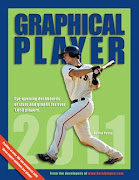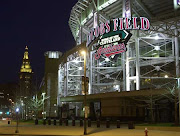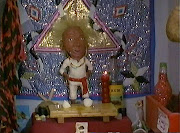Cleveland will receive 21 year-old Scott Barnes from San Francisco in exchange for Garko. Barnes was originally taken by the Nationals in the 43rd round of the 2005 draft, but opted to attend St. John's University in New York instead. He was later chosen by the Giants in the eighth-round of the 2008 draft. The southpaw has a career 2.60 ERA, 1.03 WHIP, and 3.95 K/BB ratio over 141.2 IP over his minor league career. He spent 2008 progressing through rookie-ball before settling in at Single-A San Jose for the entirety of the 2009 season, amassing a 2.85 ERA, 1.13 WHIP, 2.7 BB/9, and a strong 9.1 K/9 over 98.0 IP (18 starts). According to Anthony Castrovince, Barnes will report to Class-A Kinston.
Baseball America describes Barnes as having "surprising control of a 88-91 mph fastball that touches higher. He also throws a tight slider, average changeup and show-me curveball from a deceptive delivery." He may not have a blazing fastball in his arsenal, but it will be interesting to see how his off-speed and breaking pitches develop as he progresses through the minors. BA also projects Barnes as "a solid piece but at his best fits a mid-rotation starter profile."
If Barnes turns out to be a quality third or fourth starter for the Tribe, that seems like a very good return for Garko considering Cleveland was dealing from a position of depth at first base (likely the ultimate destination for Matt LaPorta and current part-time residence of Victor Martinez). Regardless of whether or not Martinez is traded, Garko was never destined to be the Indians' starter of the future at first base.
Another incentive for Cleveland to deal Garko was that he will be eligible for arbitration after this season, meaning he will become much more expensive for the 2010 season and beyond. Players are allowed to submit a new contract proposal through arbitration after they've been at the Major League level for three full seasons (an arbitration panel weighs the player's and team's proposals and decides what the final contract will be).
For example, Diamondbacks first baseman/outfielder Conor Jackson averaged an .822 OPS in his first three seasons in the Majors and made $419,500 in 2008. Meanwhile, Garko averaged an .806 OPS in his first three full seasons and is making $455,000 in 2009. After entering arbitration before the 2009 season, Jackson received a one-year deal worth $3.05 million (a 627% raise). It seems reasonable to expect Garko to receive a similar ruling to Jackson in arbitration next year.
At 28 years-old, there is a strong chance that Garko has either reached or is very near his ceiling as a hitter. His best overall season with the Tribe came in 2007 when he posted a .289/.359/.483 line with 21 HR, 29 doubles, and a 117 OPS+. Despite seeing his numbers drop across the board in 2008, Garko managed to tie Grady Sizemore for a team-leading 90 RBI. The 90 RBI season, an .899 OPS in nine 2007 playoff games, and a .292 career batting average with RISP have lent Garko a bit of a reputation as a clutch hitter.
Garko's trade value was probably about as high as it was going to get, so the Indians were wise to trade him now, along with their other veterans, to jump-start the rebuilding process. He may still have a couple career years in him offensively, but I'd be surprised if he saw any kind of significant, sustainable jump in his overall numbers at this point. He's a solid hitter with slightly above average on-base skills and decent power. While Garko did provide some versatility by playing the corner outfield positions and first base, he still has a below average glove overall.
I'm not sure what made San Francisco give up one of their best pitching prospects for a league average first baseman in line for a substantial raise, but I guess the Giants preferred Garko to incumbent Travis Ishikawa. Below is a comparison of the two players:
| Player | Period | PA | BA | OBP | SLG | OPS+ | UZR/150 (Inn. 1B) | WAR |
| R. Garko | 2009 | 273 | .285 | .362 | .464 | 114 | 12.1 (415.0) | 1.2 |
| Career | 1591 | .282 | .354 | .449 | 108 | -4.0 (2936.0) | 3.9 | |
| T. Ishikawa | 2009 | 239 | .268 | .319 | .409 | 90 | 19.8 (544.0) | 0.9 |
| Career | 368 | .271 | .324 | .422 | 94 | 10.0 (812.1) | 0.9 |
Garko is a modest upgrade offensively, while Ishikawa is the better defender. Garko also holds an edge batting against lefties, with a .906 career OPS versus Ishikawa's .697 (there's only a .014 difference between them against righties, despite batting from opposite sides of the plate).
Even after looking at the numbers, I'm really struggling to figure out why the Giants made this trade. As far as I can tell, only Brian Sabean truly knows and I'm not about to blow a fuse trying to figure out that guy's logic (interestingly enough, he seems to have outdone himself in the same week). Sure, Ishikawa was having a down year at the plate, but this trade seems like Sabean was starting to get desperate to upgrade San Francisco's punch-less offense and overpaid for Garko. Looking at each player's wins above replacement (WAR), this trade probably won't even make much of an impact on the Giants final record, as there's only been a .3 win difference between them so far this season.
Based on the potential for Barnes to develop into a solid mid-rotation starter in a few years, Cleveland definitely came out ahead in this trade.
As a Garko fan, it was pretty tough seeing him head for his parent's waiting car (they were in attendance for the Anaheim game) in the stadium parking lot, luggage in tow, as an STO cameraman followed him out prior to Monday's broadcast. Ryan seemed pretty downtrodden about the whole thing and I can't blame him since Cleveland is the only organization he's ever been with in the Majors. Besides leaving behind the familiarity and routine of playing for the Tribe, Garko is also leaving many players who had come up alongside him through the minors. That has to be a difficult transition for a player who's never been traded before.
Personally, Garko was a lot of fun to watch at the plate. He seemed to have a knack for digging in and making the pitcher work thanks to a quick swing that shortened up even more when he was down in the count. It was also entertaining to see him always chatting up whoever happened to be standing at first base. Regardless of who it was, it seemed like Garko would still try and hold a conversation with them (probably telling them about how he went to Stanford).
My favorite thing about Garko may have been his Thome-esque home run swing. It's no secret that Jim Thome was Garko's idol growing up (hence the number 25 on his uniform) and it shows in how he finishes his swing after crushing a ball (I'm a bit of a baseball nerd, so I thought that was kinda cool). Not that he was bereft of opportunity in Cleveland, but hopefully Garko will get to see more playing time now that he's part of a less-crowded infield. Best of luck in San Francisco, Ryan.











